Fredericksburg by Night
Battlefields at night. The darkness both hides and reveals features of the fighting ground. A different type of silence has descended or at least a subdued quiet compared to the buzz of traffic during the day. Viewing battlefield land or sites at night has challenges too; one does not want to be labeled a trespasser or have a visit from national park law enforcement. However, some battlefields have areas that are publicly accessible at all hours or have public roads cutting across the battle land which offers an opportunity to legally and cautiously explore.
(Neither Emerging Civil War nor the author approve or suggest visiting battlefield areas that close to the public after sunset or otherwise non-access provided land without permission.)
As I’m writing this blog post, it’s late in the evening of December 10—the eve of the 160th anniversary of the battle of Fredericksburg. I’m in the middle of a weekend, trying to stay confined to home and couch. The plans for going to hikes and programs hosted by the National Park Service for the anniversary and writing about those experiences ended when I badly sprained my ankle earlier in the week. A good percentage of my foot is various shades of blue and gray from the injury and bruising. A couple hours ago my foot was aching so fiercely that it was hard to rest, be comfortable, or focus on reading. The evening hour wasn’t terribly late, and I decided that my foot probably wasn’t going to hurt any more or any less if I went for a drive to view a few parts of Fredericksburg battlefield at night. Realizing that I wasn’t going to get the Fredericksburg 160th experience I had hoped for, I challenged myself to find a way to commemorate in a quiet way. I knew I had to avoid walking more than a few steps, and I decided to avoid all National Park sites out of respect for their dusk/dawn rules. But there were still plenty of places to view. I turned on my battlefields music playlist in the car and started driving.
Crossing the Rappahannock to the Stafford side of the river, I found the road that winds along the base of Stafford Heights, below Chatham House. The road was deserted, and I braked, pausing along the area of the ravine. Here, in the night 160 years ago, engineers worked to get the pontoons down to the riverbank to construct the Upper Crossing bridges. Some animal—probably startled by the headlights—rustled away into the brush. Otherwise, silence. Reflections of the modern lights of Fredericksburg shown in the river. There wasn’t anywhere to safely pull off to get photographs, so I drove slowly on. A few Christmas trees shown in the picture book windows of homes or businesses facing the river. How many soldiers never lived to see another Christmas and stood along this river?
Recrossing the river to the Fredericksburg side, I headed for the Upper Crossing site, pleasantly surprised to find a good parking spot just a few yards from the markers. Chatham House, lit by modern lighting, stared across the river, stoic and uninterested. I wondered if there were visible fires or lamps around the house in 1862 on the night of December 10 or 11 or if merely a dark silhouette marked the structure’s location. In the dark, river flowed, almost looking shiny from the view along Sophia Street. Here, Confederate marksmen waited, peering into the darkness, listening. A block or so away, laughter broke into the stillness, followed by pleasant voices. No sergeant’s hiss for silence tonight.
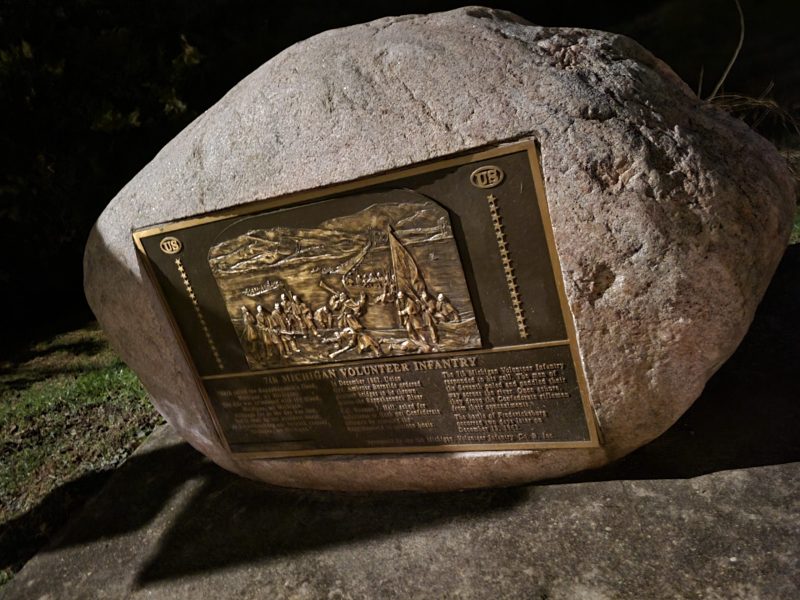

Circling the block to obey the one-way street signs, I passed through some of the fiercely-fought-over intersections near the Upper Crossing site. I paused to make the left turn onto Princess Anne Street. On the corner sits the modern pub, Red Dragon Brewery. A lone microphone caught my eye; it was clearly set up for a performer who must have finished or was taking a breaking. Voices silenced, I thought. Unable to tell their stories, unable to live longer on this earth because of what happened on this urban battlefield. I drove on, slowly moving down Hawke Street, crossing Caroline Street—a fateful intersection on December 11, 1862.

Weaving through the old streets of Fredericksburg, I pulled up at a signal light. The Baptist Church sat to my left, its steeple silhouetted against the sky. Like many other buildings, this church was here in 1862, 1863, and 1864, witnessing all the major moments of military or medical invasion of this town along the Rappahannock.
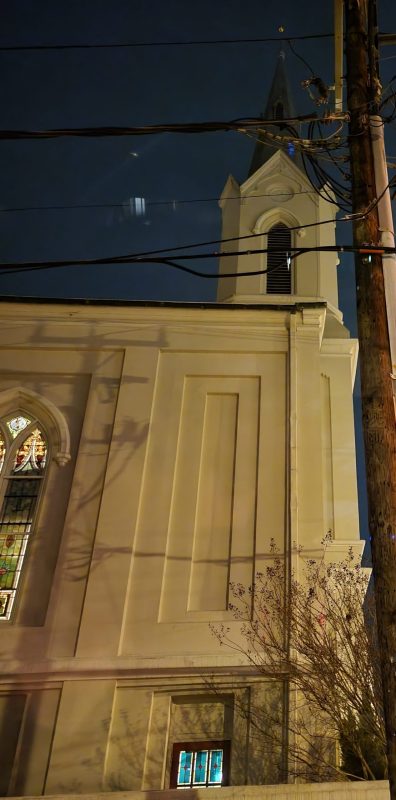
I turned the car into the deserted parking lot of the city dock. I knew better than to linger long here, but I wanted a few photographs. The planking of the modern docks, the soft sound of the water against the structures, the mid-stream reflections all contributed to a moment when I almost expected the fog to descend and the engineers to appear from the mists of time. I looked back toward the high ground of the bank. Where Christmas sparkled tonight, in those shadows, 160 years ago, more Confederate sharpshooters waited. The old lane—one of my favorite places on Fredericksburg “battlefield”—beckoned, but I could not walk the footsteps tonight…I could only look and listen to the quiet as if it held the secrets of those who came before.

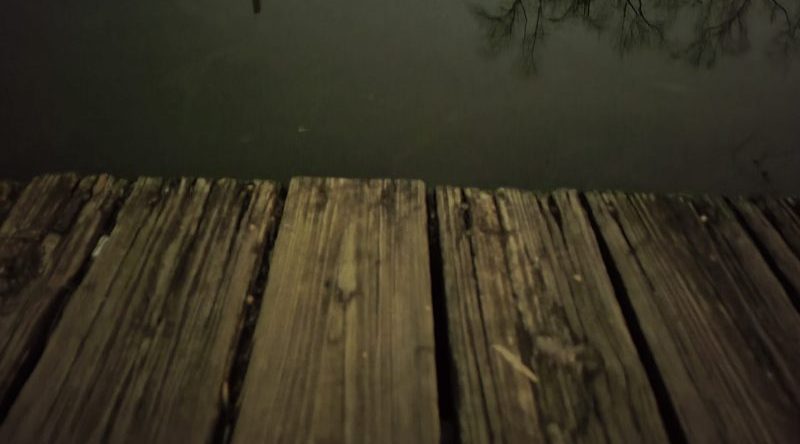

A shadow of a chain (part of the monument) lay across the Irish Brigade’s monument near the City Dock. I shivered in the cold, trying to decide if it had a deeper meaning in the play of light and darkness. The bonds of famine that had driven so many Irish to revolution or refugeeing? The chains of immigrant prejudice that the men of the Irish Brigade tried to break with courageous actions? A combination of the two…or something still yet un-thought of? A trimmed hedge of boxwood surrounds the monument, a reminder of the sprigs placed in the caps of the Irish soldiers on December 13, 1862, to prove how far they advanced when their bodies were found. Above the boxwood, the light branches of a tree reached toward the sky.


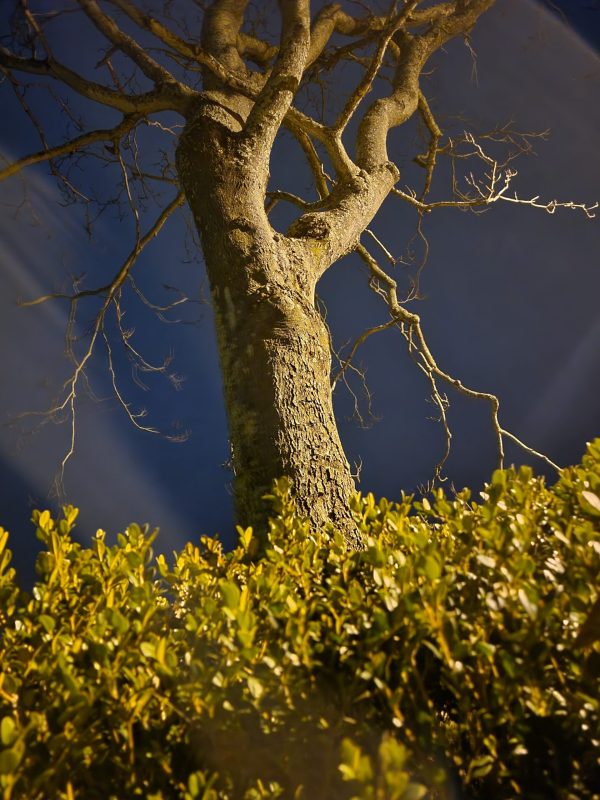
Beyond the 1862 limits of Fredericksburg, I signaled early and pulled into Slaughter Pen Farm. Normally an area to not visit after dark, I knew that some reenactors might still be on the preserved ground (held by American Battlefield Trust) and decided to make a quick stop. The field stretched away into the shadowed darkness, the secrets of the terrain covered in the gloom. The air was cold, low 40s according to the gauge in the car. Beyond the railroad tracks, the trees protected the low swamp and Prospect Hill lay further beyond. One of the lone trees in front of the parking area pointed accusing branches at the sky.

Unwilling to concern anyone who might be at the few tents I thought I saw in the dark field, I left Slaughter Pen Farm quietly. I debated if stopping at Pelham’s Corner at night would be a good idea or not; in the end, I decided it was too late to call the Central Virginia Battlefield Trust staff and ask and that if I stopped for two minutes, took a photo, and didn’t throw any trash on the lawn it would probably be okay. From my perspective on the preserved land, the marker cannon’s silhouette stood out against the glaring lights of the modern convenience stories and the shadows of the growing cedars. However, I knew that in the dark from the road, the cannon is nearly invisible to the passersby on the road except for brief seconds when headlights flashed across the scene. It reminded me of Pelham’s “invisible” cannon on December 13, 1862, nestled in low ground, protected by low brush, and moved by the gunners to prevent the enemy cannoneers from ever getting a clear target on that troublesome officer and lone Napoleon gun advanced beyond the Confederate lines.
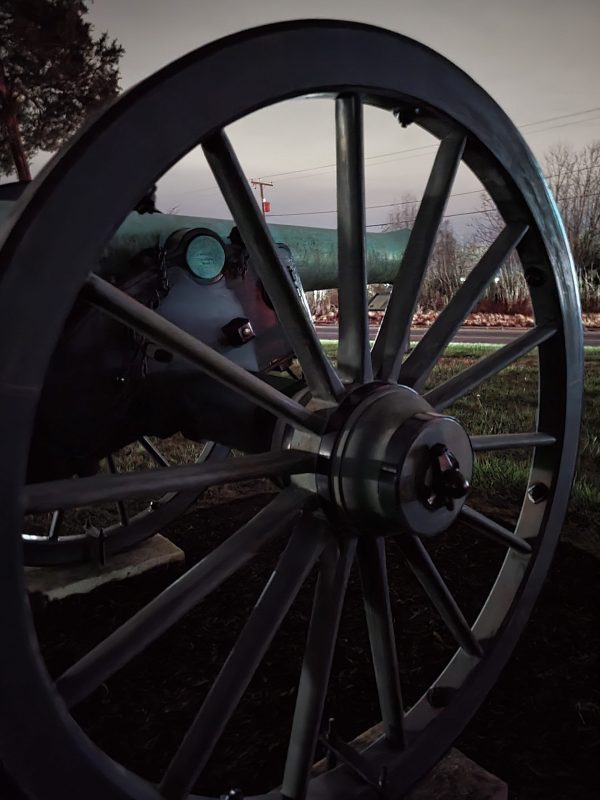
I drove toward home. My foot still ached badly, but I was satisfied that I had found a way to see and remember at Fredericksburg for the 160th anniversary. Making the final turns into the community where I live, another song came up on my playlist: “Johnny has gone for a soldier.” One of my long-time favorites. I had seen no ghosts nor did I expect to. But Fredericksburg in the dark held that mystery…that thought that tragedies were not so very far away. Just 160 years. So, as the lyrics of the old war-song ask, “who would blame me cry my fill” and “only time will heal my woe.” A century and six decades ago—on the eve of battle—soldiers lined the Rappahannock. In just three days, an estimated 18,500 men fell: dead, wounded, missing. Gone as soldiers.
Excellent post, Sarah. What is the importance of the historic lane leading up to Caroline Street? I have never read a reference to this before today.
Thanks, Brian. Hawke Street is where the 7th Michigan and 20th Massachusetts advanced into Fredericksburg as they secured the Upper Crossing. As they reached the intersection with Caroline Street, Confederates opened fire from the second and third story windows of the homes around the intersection, creating a deadly crossfire. The battle for this intersection was intense on December 11, 1862
Sarah, what a terrific and thoughtful story you tell. A great and meaningful read on a peaceful Sunday morning.
Thanks, Ted.
A beautiful read. Thanks.
Nice thanks
Awesome Adventure, Thank You
Great story, Sarah! Great photos, and very poignant narration. Merry Christmas.
Oy! Hope your foot gets better.
Thanks. Doing much better and was able to do some field work today.
Great post, Sarah, as is your earlier one on Irish music. I was a big fan of Peter, Paul, and Mary way back when, and their great rendition of “Johnny’s gone for a soldier” is etched on my heart, including some Irish lyrics. Can still “sing” some of it, and I’m part Irish.
How nice!
That is one of the nicest pieces of writing I’ve come across in a while. Thanks
Thanks for reading, Don.
great, great post
Great story of your night-time battlefield visit. I felt I was driving along in the front seat with you. Thanks for the Fredericksburg ride!
A lovely telling/illustration.
Sarah, the lane to Caroline Street is something new to me. Your reference to the locations of the sharpshooters prompted chilling images.
Wonderful article. Thanks
A lovely account
Nice storytelling, thanks
Sarah – Sorry about your foot, but the injury led to the beautiful story of your night drive around the Fredericksburg battlefield. I enjoyed reading it! Thanks!
Thank you, Frank. I’m glad I could share part of the journey.
I must say, for one so young you have a tremendous ability with the written word. I was greatly moved by your post, and although I have never been to the Fredricksburg battle field, I felt that I was with you as I read.
great story—inspires me to make another visit
Great post!! Best wishes for a speedy recovery!
Thanks! Doing much better, but still taking it semi-easy with walking.
Once again, you enhanced the knowledge of those who can study/read about historic sites but do not have the good fortune to
go “yondering” upon them. The descriptions of your evening visit is both informative and entertaining.
Well Done and Thank You!!
ps. How is the ankle? Trust you are mending well and will soon be able to do more yonderings.